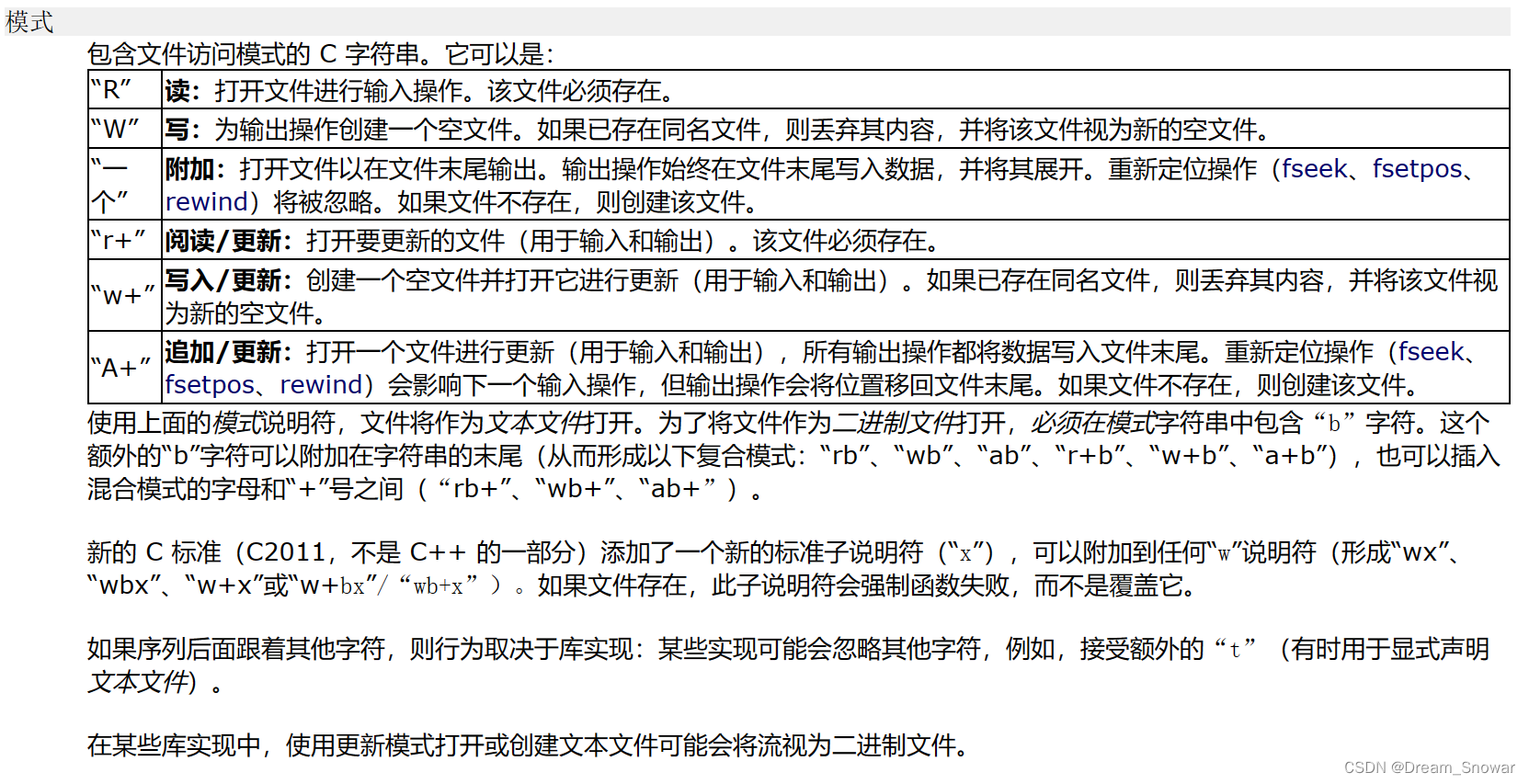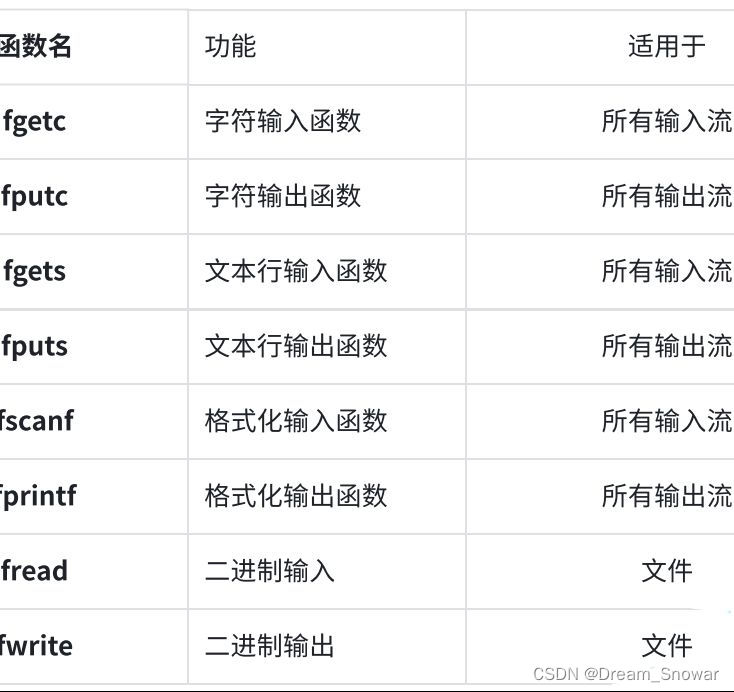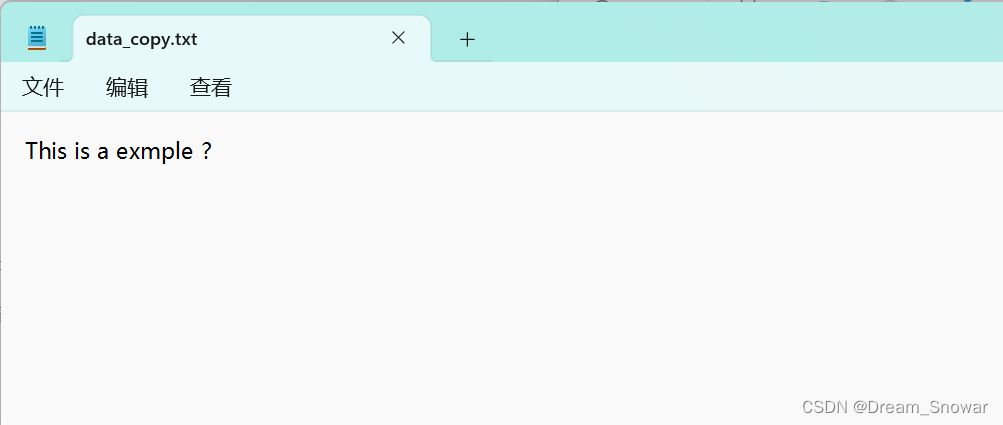【C语言】文件操作
发布时间:2024年01月18日
一、基础认识
首先让我们先来认识一下什么叫文件。
文件名:
?个文件要有?个唯?的文件标识,以便用户识别和引用。
文件名包含3部分:文件路径+文件名主干+?件后缀
例如:
c:\code\test.txt
为了方便起见,文件标识常被称为文件名。
我们写的程序的数据是存储在电脑的内存中,如果程序退出,内存释放,数据就会丢失 ,等下一次次运行程序,是看不到上次程序的数据的,如果要将数据一直保存,我们可以使用文件。
我们?般谈的文件有两种:程序文件、数据文件。
程序文件:
我们可能看到过一些文件后缀为.c .obj .exe等这些都是程序文件,.c是源程序文件,。obj是目标文件,.exe是可执行文件。
数据文件:
文件的内容不一定是程序,而是程序运行时读写的数据,比如程序运行需要从中读取数据的文件,或者输出内容的文件。????????
?

二进制文件和文本文件?
根据数据的组织形式,数据文件被称为文本文件或者二进制文件。
数据在内存中以?进制的形式存储,如果不加转换的输出到外存,就是二进制文件。
如果要求在外存上以ASCII码的形式存储,则需要在存储前转换。以ASCII字符的形式存储的文件就是文本文件。
那么,数据在内存中是怎么存储的?
字符?律以ASCII形式存储,数值型数据既可以用ASCII形式存储,也可以使用二进制形式存储。
如有整数10000,如果以ASCII码的形式输出到磁盘,则磁盘中占用5个字节(每个字符?个字节),而二进制形式输出,则在磁盘上只占4个字节。
(这个结果不一定,得看环境)
二、文件的打开和关闭
1.?流和标准流
1.1流
我们程序的数据需要输出到各种外部设备,也需要从外部设备获取数据,不同的外部设备的输?输出操作各不相同,为了方便程序员对各种设备进行方便的操作,我们抽象出了流的概念,我们可以把流想象成流淌着字符的河。
C程序针对文件、画面、键盘等的数据输入输出操作都是通过流操作的。
?般情况下,要想向流里写数据,或者从流中读取数据,都是要打开流,然后操作。
1.2 标准流
那么问题来了,为甚么我们冲键盘输入是就不需要打开流呢?
因为C语言程序在启动的时候,默认打开了3个流:
stdin
:标准输入流,在大多数的环境中从键盘输入,scanf函数就是从标准输入流中读取数据。
stdou
t:标准输出流,大多数的环境中输出到显示器界面,printf函数就是将信息输出到标准输出 流中。
stderr
:标准错误流,大多数环境中输出到显示器界面。
就是因为默认打开了这三个流,我们使用scanf、printf等函数才可以直接进行输入输出操作的。
而
stdin、stdout、stderr 这三个流的类型是:
FILE*
,它通常称为文件指针。
而
C语言中,就是通过
FILE*
的文件指针来维护流的各种操作的。
2.文件指针
其实每个被使用的文件都在内存中开辟了?个相应的文件信息区,用来存放文件的相关信息(如文件的名字,文件状态及文件当前的位置等)这些信息是保存在?个结构体变量中的。该结构体类型是由系统声明的,取名FILE
例如:VS2013编译环境提供的 stdio.h 头文件中有以下的文件类型申明:
struct _iobuf {
char *_ptr;
int _cnt;
char *_base;
int _flag;
int _file;
int _charbuf;
int _bufsiz;
char *_tmpfname;
};
typedef struct _iobuf FILE;当然这是在这个编译器下面的,不同的编译器的FILE不尽相同,但整体大同小异。
每当打开一个文件的时候,系统会根据文件的情况自动创建?个FILE结构的变量,并填充其中的信
息,我们不必关心细节。
?般都是通过?个FILE的指针来维护这个FILE结构的变量,这样使用起来更加方便。
创建FILE*指针变量:
FILE* pf;这个也叫文件指针变量
定义pf是?个指向FILE类型数据的指针变量。可以使pf指向某个文件的文件信息区(是?个结构体变量)。通过该文件信息区中的信息就能够访问该文件。也就是说,通过文件指针变量能够间接找到与它关联的文件。
3。文件的打开和关闭
文件在读写之前应该先打开文件,在使用结束之后应该关闭文件。
在编写程序的时候,在打开文件的同时,都会返回?个FILE*的指针变量指向该文件,也相当于建立了指针和文件的关系。
ANSIC 规定使用?
fopen
函数来打开文件,
fclose
来关闭文件。
//打开?件
FILE * fopen ( const char * filename, const char * mode );
//关闭?件
int fclose ( FILE * stream )
mode表示文件的打开模式,下面都是文件的打开模式:


代码示例:
#include <stdio.h>
int main ()
{
FILE * pFile;
//打开?件
pFile = fopen ("myfile.txt","w");
//?件操作
if (pFile!=NULL)
{
fputs ("fopen example",pFile);
//关闭?件
fclose (pFile);
}
return 0;
}三、文件的顺序读写
1.?顺序读写函数

上面说的适用于所有输入流?般指适用于标准输入流和其他输入流?
? ? ? ? ? ? ? ? ? ? ? ? ?所有输出流?般指适用于标准输出流和其他输出流
这里我用上面的代码写一个拷贝文件的代码:
#include<stdio.h>
int main()
{
FILE* pFile1;
FILE* pFile2;
char c;
pFile1 = fopen("data.txt", "r");
if (pFile1 == NULL)
{
perror("fopen->data.txt");
return 1;
}
pFile2 = fopen("data_copy.txt", "w");
if(pFile2==NULL)
{
fclose(pFile1);
pFile1 = NULL;
perror("fopen->data_copy.txt");
return 1;
}
while ((c = fgetc(pFile1)) != EOF)
{
fputc(c, pFile2);
}
fclose(pFile2);
fclose(pFile1);
return 0;
}我们先创建一个文本文件:data.txt


然后运行代码:
我们得到了这个拷贝的文件 data_copy.txt

对比前面的我们发现拷贝成功了
四、文件的随机读写
1.fseek
int fseek ( FILE * stream, long int offset, int origin );代码示例:
#include <stdio.h>
int main ()
{
FILE * pFile;
pFile = fopen ( "example.txt" , "wb" );
fputs ( "This is an apple." , pFile );
fseek ( pFile , 9 , SEEK_SET );
fputs ( " sam" , pFile );
fclose ( pFile );
return 0;
}运行结果:
我们创建了一个文本文件,记录着这个:

2.ftell
返回文件指针相对于起始位置的偏移量
long int ftell ( FILE * stream );代码示例:
#include <stdio.h>
int main ()
{
FILE * pFile;
long size;
pFile = fopen ("myfile.txt","rb");
if (pFile==NULL)
perror ("Error opening file");
else
{
fseek (pFile, 0, SEEK_END); // non-portable
size=ftell (pFile);
fclose (pFile);
printf ("Size of myfile.txt: %ld bytes.\n",size);
}
return 0;
}运行结果:
如果你直接运行,结果一定是这个

因为没有相应文件
所以你要创建一个相应的文件

然后运行,结果是:

3 rewind
让文件指针的位置回到文件的起始位置
void rewind ( FILE * stream );代码示例:
#include <stdio.h>
int main ()
{
int n;
FILE * pFile;
char buffer [27];
pFile = fopen ("myfile.txt","w+");
for ( n='A' ; n<='Z' ; n++)
fputc ( n, pFile);
rewind (pFile);
fread (buffer,1,26,pFile);
fclose (pFile);
buffer[26]='\0';
printf(buffer);
return 0;
}这个是先写入,再打印
运行结果
五、文件读取结束的判定
1.?feof
牢记:在文件读取过程中,不能用feof函数的返回值直接来判断文件的是否结束。
feof
的用是:当文件读取结束的时候,判断是读取结束的原因是否是:遇到文件尾结束。
1)文本文件读取是否结束,判断返回值是否为 EOF( fgetc ),或者 NULL( fgets )
例如:
1.fgetc 判断是否为 EOF .
2.fgets 判断返回值是否为 NULL .
2)二进制文件的读取结束判断,判断返回值是否小于实际要读的个数。
例如:
fread判断返回值是否小
于实际
要读的个数。
六、文件缓冲区
ANSIC 标准采用“缓冲文件系统”处理的数据文件的,所谓缓冲文件系统是指系统自动地在内存中为
程序中每?个正在使用的文件开辟?块“文件缓冲区”。从内存向磁盘输出数据会先送到内存中的缓
冲区,装满缓冲区后才?起送到磁盘上。如果从磁盘向计算机读入数据,则从磁盘文件中读取数据输?到内存缓冲区(充满缓冲区),然后再从缓冲区逐个地将数据送到程序数据区(程序变量等)。缓冲区的大小根据C编译系统决定的。
注意:因为有缓冲区的存在,C语言在操作文件的时候,需要做刷新缓冲区或者在文件操作结束的时候关闭文件。
这篇较为重要推荐自己多多尝试
文章来源:https://blog.csdn.net/2301_80017277/article/details/135670605
本文来自互联网用户投稿,该文观点仅代表作者本人,不代表本站立场。本站仅提供信息存储空间服务,不拥有所有权,不承担相关法律责任。 如若内容造成侵权/违法违规/事实不符,请联系我的编程经验分享网邮箱:chenni525@qq.com进行投诉反馈,一经查实,立即删除!
本文来自互联网用户投稿,该文观点仅代表作者本人,不代表本站立场。本站仅提供信息存储空间服务,不拥有所有权,不承担相关法律责任。 如若内容造成侵权/违法违规/事实不符,请联系我的编程经验分享网邮箱:chenni525@qq.com进行投诉反馈,一经查实,立即删除!
最新文章
- Python教程
- 深入理解 MySQL 中的 HAVING 关键字和聚合函数
- Qt之QChar编码(1)
- MyBatis入门基础篇
- 用Python脚本实现FFmpeg批量转换
- geemap学习笔记028:Landsat8计算时间序列NDVI并导出
- 小程序基础学习(组件传参)
- 3D模型如何制作透明玻璃材质
- 和宝贝一起迎接冬日里的浪漫~优雅有气质
- 详解Mockito
- 积萨伯爵,一个充满魅力和创意的品牌,永远创新,永不停止
- 设计螺栓长度的基本原理和细节考虑——SunTorque智能扭矩系统
- LLM推理部署(七):FireAttention——通过无损量化比vLLM快4倍
- 生态茶园建设方案——福建蜂窝物联
- C#- Attribute(特性)